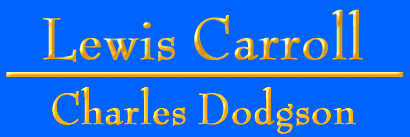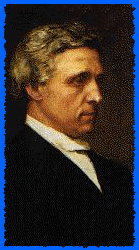|
|
|
|
| |

|
| |
 |
 hroughout
the last 100 years, the writings of a shy mathmetician
and photographer from England have captivated the minds
of people from all walks of life. From the youngest to
the oldest, wisest to the most niave, Charles Lutwidge
Dodgson (aka Lewis Carroll) has been fascinating readers
with tales of the imagination. hroughout
the last 100 years, the writings of a shy mathmetician
and photographer from England have captivated the minds
of people from all walks of life. From the youngest to
the oldest, wisest to the most niave, Charles Lutwidge
Dodgson (aka Lewis Carroll) has been fascinating readers
with tales of the imagination.
Born in 1832, he lectured at the mathematics at Oxford starting in 1855. Besides his obvious interest in that field, he liked photography. His pictures of a little girl
named Alice Pleasance Liddel (the daughter of the Dean of Christ Church), are probably the most famous. It was this little girl that inspired him to write his now famous Alice in Wonderland and Through the Looking Glass stories (see below).
But these were just the beginning. He went on to write other stories, poetry and even published a series of logic problems.
|
In addition to these, he published some math and logic texts as well. A small sample of each of these things is covered in this site, but this is in no way an exhaustive treatise on the man. There are a fair number of other web sites that provide much more information than this one will.
When constructing this memorial to the man, I merely hoped to awaken you to the knowledge of how one man can influence the minds of so many while casually spending the day in a boat, on a river, with some of the most wonderful of God's creations: children. Charles Dodgson's work can been seen in everything from classic literature to science fiction. I have seen computer textbooks and science textbooks with his characters in them,
and his work has been immortalized in both song and cinema. If you carefully keep a watchful eye out you too may see a White Rabbit "pop down a large rabbit-hole under the hedge." If you do, then I can only hope that you take chase - and give your fantasies flight. |
 lice
in Wonderland is
by far the most widely known of Dodgson's writings. It
has been translated into dozens of languages and is available
in many forms online. Even Project Gutenberg has seen
fit to pick make it available in their online texts.If
you only get a chance to read one of the lewis Carroll
stories, then this is the one I have to reccomend. lice
in Wonderland is
by far the most widely known of Dodgson's writings. It
has been translated into dozens of languages and is available
in many forms online. Even Project Gutenberg has seen
fit to pick make it available in their online texts.If
you only get a chance to read one of the lewis Carroll
stories, then this is the one I have to reccomend.
In this story, a little girl falls down a rabbit hole and into a mysterious world that is filled with talking animals, crazy hatters, and egocentric royalty. As long as your read this with the open-mindedness of a child, you will not only enjoy it, but come to appreciate the references to it as you run across them
in our culture.
|
|
 hrough
the Looking Glass is
another story about little Alice and her adventures in
the looking glass (mirror) world. A world in which everything
is backwards. People run to stay where they are, pain
comes before the event that causes it, etc. This story
is just as creative and imaginitive as the the Wonderland
story, but with all new characters (excepting Alice, of
course!) and a new plot. Carroll used the game of Chess
as a background for this particular story, instead of
the deck of cards he used in his first story. Again, I
reccomend this book if you have the chance to read it.
There are a lot of references to it in our culture too;
although, not quite as many Wonderland. hrough
the Looking Glass is
another story about little Alice and her adventures in
the looking glass (mirror) world. A world in which everything
is backwards. People run to stay where they are, pain
comes before the event that causes it, etc. This story
is just as creative and imaginitive as the the Wonderland
story, but with all new characters (excepting Alice, of
course!) and a new plot. Carroll used the game of Chess
as a background for this particular story, instead of
the deck of cards he used in his first story. Again, I
reccomend this book if you have the chance to read it.
There are a lot of references to it in our culture too;
although, not quite as many Wonderland.
|
|
 he
hunting of the Snark is
by no means the most well known of Carroll's writings,
but it no self-respecting fan of his has failed to read
it. It is a unique work in that it combines the elements
and wit of his poetry with a story. Some might call it
an epic poem, though it is far smaller than what most
would consider to be an epic. Nevertheless, that is the
best way I can think of to describe this piece. It is
an enjoyable read and I hope that you find the time to
take it in! he
hunting of the Snark is
by no means the most well known of Carroll's writings,
but it no self-respecting fan of his has failed to read
it. It is a unique work in that it combines the elements
and wit of his poetry with a story. Some might call it
an epic poem, though it is far smaller than what most
would consider to be an epic. Nevertheless, that is the
best way I can think of to describe this piece. It is
an enjoyable read and I hope that you find the time to
take it in!
|
|
 ylvie
and Bruno, like The
Hunting of the Snark, is not a well known work of
Carrolls. It is also a much more difficult piece to read,
but worth it. This story about two children and the kingdowm
they live in is full of interesting verbal illustrations
and tongue twisters. It is a little more difficult to
find than some of his other works, but worth taking the
time to look for it. I will include a link to an ascii
text version (if any are available) on the W
i g a n d ' s W o r l d Web Links page. ylvie
and Bruno, like The
Hunting of the Snark, is not a well known work of
Carrolls. It is also a much more difficult piece to read,
but worth it. This story about two children and the kingdowm
they live in is full of interesting verbal illustrations
and tongue twisters. It is a little more difficult to
find than some of his other works, but worth taking the
time to look for it. I will include a link to an ascii
text version (if any are available) on the W
i g a n d ' s W o r l d Web Links page.
|
|
 few
of my favorite selections
from Dodgson's vast collection of poetry have been presented
here for your amusement. If you enjoy these silly verses,
then maybe you'll be inspired to read more, or even write
some of your own (as I have done!) Included on this page
are You Are Old Father William, Jabberwocky, an acrostic,
as well as a few others. few
of my favorite selections
from Dodgson's vast collection of poetry have been presented
here for your amusement. If you enjoy these silly verses,
then maybe you'll be inspired to read more, or even write
some of your own (as I have done!) Included on this page
are You Are Old Father William, Jabberwocky, an acrostic,
as well as a few others.
|
|
 ogic
problems come in many
various forms, but those that Dodgson wrote are probably
of some of the most famous. His syllogisms are not only
complicated, but very well written, and reflect his creativity.
Some of them even incorporate items from other works.
There are several web sites already dedicated to his mathematical
work, so I won't go into a lot of detail in this section.
A brief explanation of his own history with math, and
an example or two can be found on this page. ogic
problems come in many
various forms, but those that Dodgson wrote are probably
of some of the most famous. His syllogisms are not only
complicated, but very well written, and reflect his creativity.
Some of them even incorporate items from other works.
There are several web sites already dedicated to his mathematical
work, so I won't go into a lot of detail in this section.
A brief explanation of his own history with math, and
an example or two can be found on this page.
|
|
 he
photos that this remarkable
influence shot have been collected and discussed by an
amazing number of people. I have included some of them
because I feel like it is good to get an idea of who the
whole man was. It is important to remember as you view
these pictures, that photography was still new to the
world at this time. He reveled in the challenge it represented. he
photos that this remarkable
influence shot have been collected and discussed by an
amazing number of people. I have included some of them
because I feel like it is good to get an idea of who the
whole man was. It is important to remember as you view
these pictures, that photography was still new to the
world at this time. He reveled in the challenge it represented.
|
|
|
|